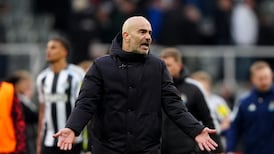Greatest Shots: Number nine Sandy Lyle: 1988 MastersGOLF: Sandy Lyle watched his tee-shot off the 72nd hole in the 1988 US Masters at Augusta National and knew it was destined for one of the two fairway bunkers on the left-hand side.
One look to his caddie Dave Musgrove confirmed his worst fears and, as player and bagman walked up the final fairway, Lyle - through grimaced teeth - remarked: "I've had it. If it is in the first bunker, I have had it."
This was a time when the bunkers on this famous hole were still very much in play, before the course was lengthened and before equipment changes to ball and club necessitated such change.
When the pair walked up to the sand traps, the Scot's intuition was proven to be partly correct. He was in the first bunker but the ball had somehow managed to roll back from the lip and was about three feet from the front of the sand, at least giving him the option of going for the green.
Still, it was a devilishly difficult shot to play; and all the more so when the US Masters title was on the line.
At that stage, Lyle, who at one point during the day held a three-stroke lead, was level for the lead with Mark Calcavecchia, who had overcome a bogey-bogey start to his final round to hit back with four birdies in the next six holes and claim the clubhouse lead on six-under.
Lyle, on six-under and with his shoes digging into the sand on the final hole, had a dilemma. If he took on the shot to the green, it had a strong chance of hitting the lip. If he played out short of the green, he would still have a difficult up-and-down to force a play-off with Calcavecchia.
The caddie didn't want Lyle to take on the shot, believing that the lip was too close for comfort. In any way, Lyle's final round play had included just about every shot in the book. Some magnificent iron play - he set up birdies on the second, ninth and 16th with his seven-iron - and a chip-in birdie on the fourth had been offset by other less than spectacular play including a couple of three-putts and even a nightmare time on the 12th where he put his eight-iron tee-shot into the water that guards the green.
In his own mind, Lyle knew that he would always take on the shot - but knew too that it would have to be perfect. He considered playing an eight-iron, but instead asked Musgrove to hand him a seven-iron. The caddie took the rake in his hand, walked eight yards to Lyle's right and prised the rake in his left hand as if using it as a crutch while awaiting the most important shot of his master's golfing life.
Lyle's view of the flag was obscured by the second fairway bunker, but his short and powerful swing made the perfect connection with the ball.
It missed the lip by no more than an inch and flew high towards the green. Lyle knew it was good, and raced out of the bunker. What he just about managed to see was the ball landing on the bottom level of the green and then running up the tier that runs through the middle.
For a short time, it looked as if the ball would remain on the ledge, but it moved slowly back down the slope towards the hole and finished 10 feet away.
He holed the birdie putt, and won the 1988 US Masters - the putt won the title, but it was the bunker shot that was the shot of Lyle's life.
"To win the way I did with the seven-iron from the bunker is something I will always remember," recalled Lyle.
At the end of the series, readers can vote for the Five Greatest Golf Shots Ever - the reader whose selections correspond with the shots selected by our Irish Times panel will enter a draw to win a custom fit Titleist 975J driver.












